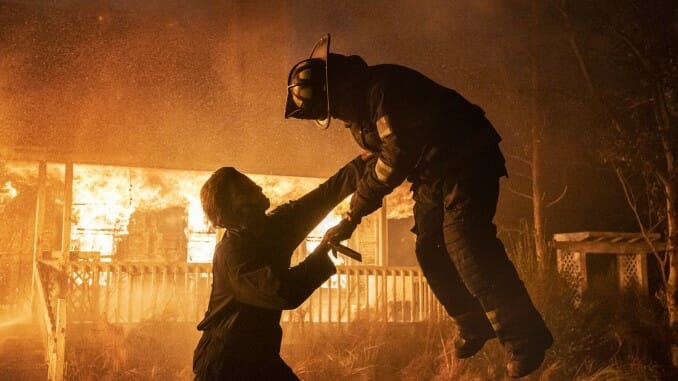Cynical Sequel Halloween Kills Gorily Treads Water
Photos via Universal Pictures
“Evil dies tonight.” That’s the rallying cry of the town of Haddonfield in the wake of a new slew of murders committed by Michael Myers, and it’s also the tagline of David Gordon Green’s Halloween Kills. That slogan is unambiguous in terms of the promise it’s making to the audience—you’re going to witness the death of a foundational slasher killer, come what may. No wiggle room is afforded … and that’s immediately a problem, because every person sitting down to watch Halloween Kills in theaters or via Peacock this weekend is likely fully aware that another sequel, Halloween Ends, is still due out in October of 2022. Knowing that, ask yourself: Do you believe that Green and co. would have the guts to go through with their own tagline? Would they dare kill off the cash cow of Michael Myers? Or is it more likely they’d string audiences along yet again, en route to one more payoff? I think we all know the most likely answer.
Halloween Kills is subsequently a cynical sequel, without much esteem for its own audience, although it is frequently quite entertaining of its own merits. Like Green’s first 2018 Halloween reboot, this is a badly overstuffed film that largely ignores the inherent strength of what should be its central story—three generations of Strode women, facing down The Boogeyman—in favor of random, gratuitous action scenes and endless subplots. It is perhaps marginally more focused than the 2018 entry, all told, but we still spend an incredible amount of time jumping around to minor viewpoint characters instead of working to enrich the central narrative.
Ever since 2018, I’ve been trying to wrap my head around why Green and co-writer Danny McBride specifically chose to go this route in seemingly making the scope of Halloween as wide as they possibly could. The original 1978 film from John Carpenter is a masterclass in intimacy and economy of characters, revolving around just a handful of babysitters, their wards and a frenzied Dr. Loomis, which allows time to truly get a handle on these people. The modern Halloween sequel trilogy—it should go without saying that making THREE FILMS was purely an economics decision—responds to this by taking the exact opposite tack, slathering every frame with an abundance of characters and locations, all of which reduce the prominence of the people who would seemingly be the primary protagonists. Andi Matichak’s Allyson, the granddaughter of Jamie Lee Curtis’ final girl Laurie Strode, is perhaps the greatest victim of this sidelining—she has all the makings of a lead protagonist (and seemed to be, at times, in the 2018 film), but here she literally doesn’t have a one-on-one dialogue scene with anyone for the first 40 minutes. And when she finally does, it lasts a few moments before the film skitters off in a new direction like a frightened squirrel.
Who does the film consider of greater interest than characters like Allyson? Well, practically everyone. There’s the old, bickering couple who enjoy “Cheez-Its and Beaujolais” brutally slain in their home by Myers for no apparent reason. There’s Lonnie Elam, the little bully boy from the original Halloween whom Dr. Loomis once yelled at from the bushes, brought back into the fold because audiences were obviously asking themselves “whatever happened to Lonnie?” There’s a trio of annoying children playing practical jokes on the neighborhood, or the couple of gay men living in the renovated old Myers house. Side note: Former Mad TV actor Michael McDonald makes himself into a horror movie trivia answer here by arguably becoming the first actor ever killed by both Michael Myers and Warwick Davis’ Leprechaun, having previously been murdered in 1994’s Leprechaun 2.
To their credit, Green and McBride are indeed getting at something here—the true thematic focus (the literal focus is action) of Halloween Kills is actually the crippling effect that Michael’s legacy has had on Haddonfield itself, and its residents. It’s a story about the psychic scars and the trauma felt by residents like Tommy Doyle (Anthony Michael Hall), the little boy being babysat by Laurie Strode in 1978, and the collective panic and mania experienced by the town when the threat of Michael Myers reemerges. These are themes that are being recycled wholesale from 1988’s oft-criticized Halloween 4: The Return of Michael Myers, in which a lynch mob accidentally shoots a resident of the town while hunting for Myers. Here, the mob is mobilized once again, and they instead descend on a likely scapegoat, making a fair point about mob mentality and vigilantism. The film, however, wants to have it both ways, condemning the bloodthirsty mob at the same time that we’re also meant to be cheering them on as they finally track down Myers. Still, this is by far the most interesting and ethically gray aspect of Halloween Kills, even though it comes at the price of again minimizing the Strode women, especially Allyson and Laurie.